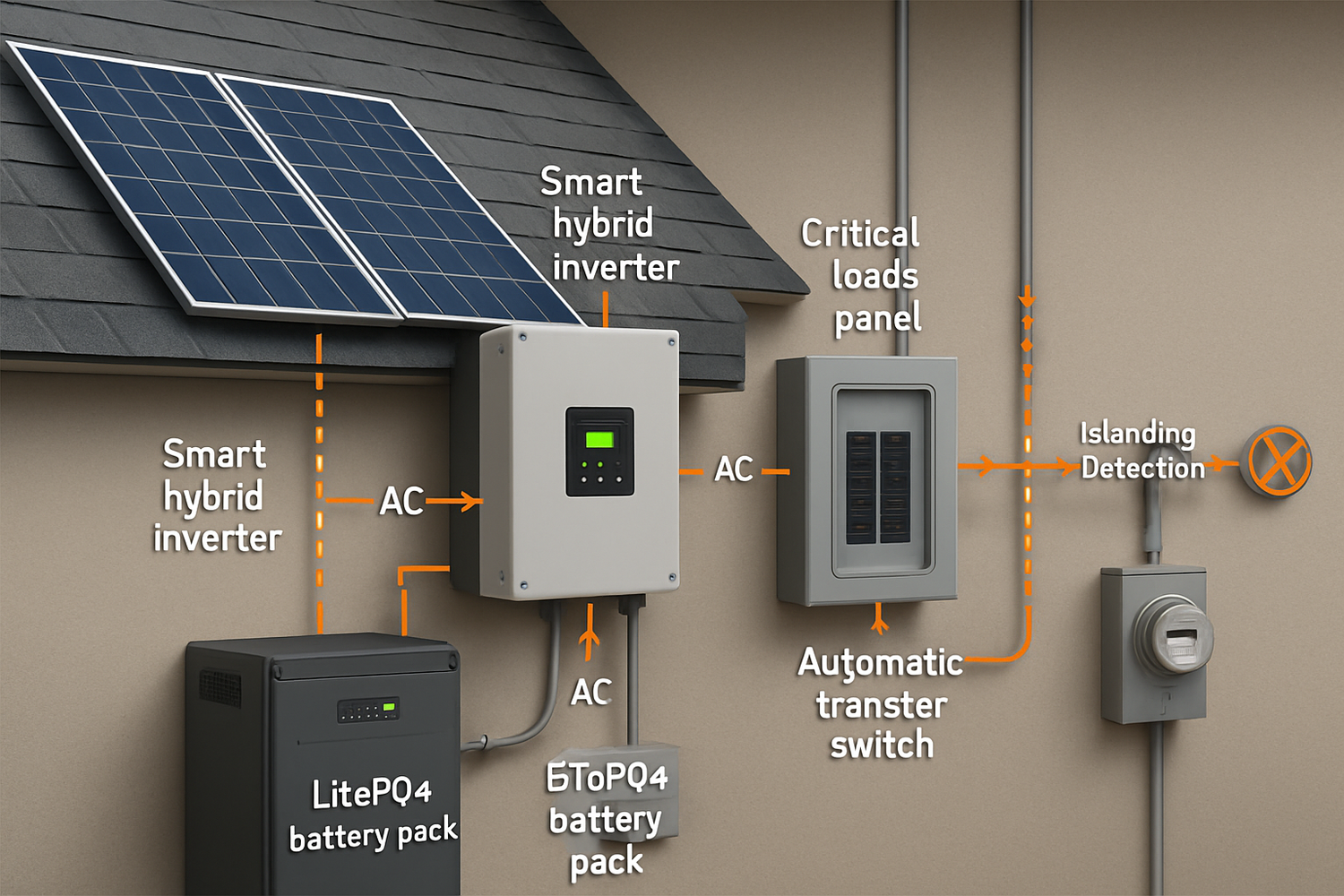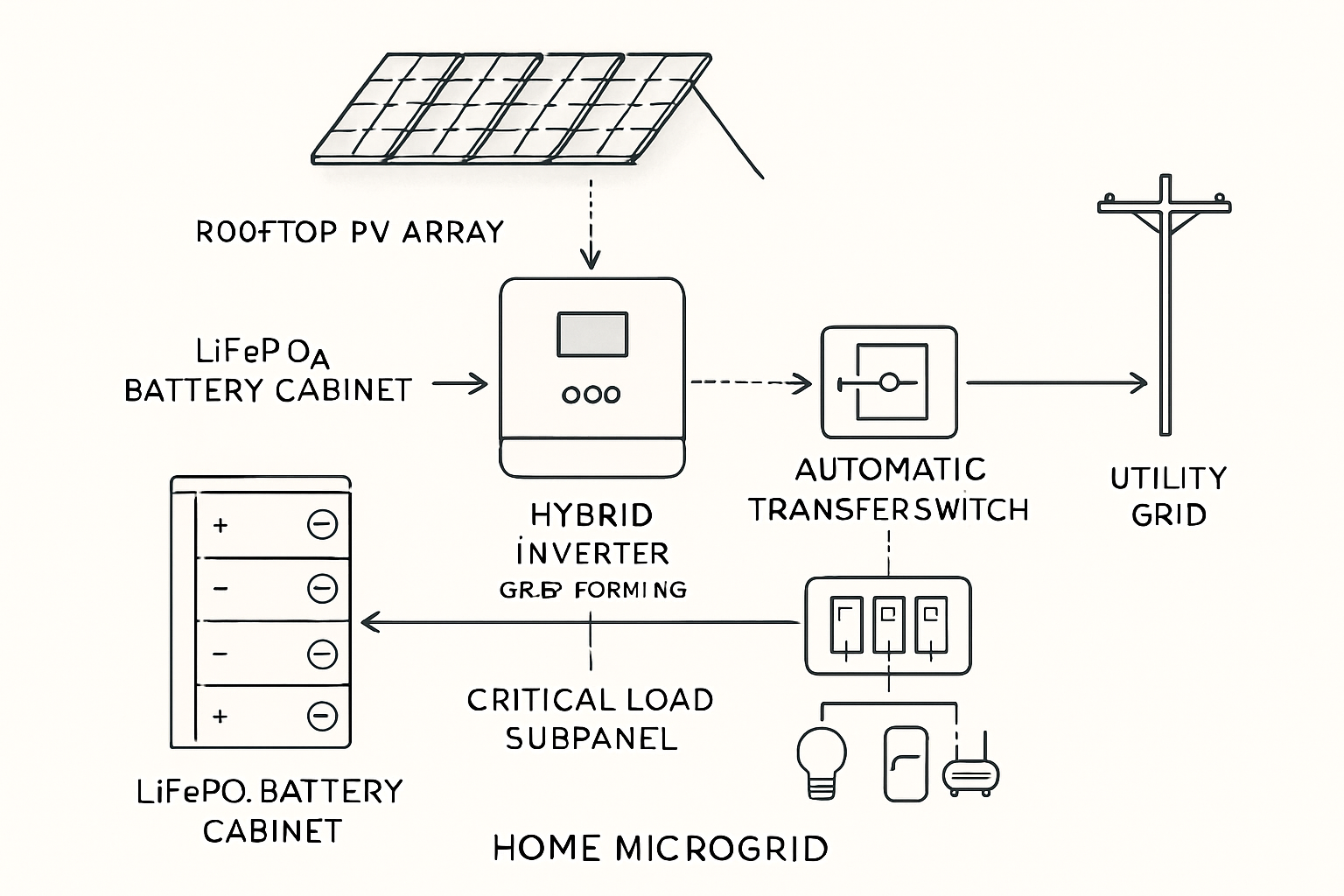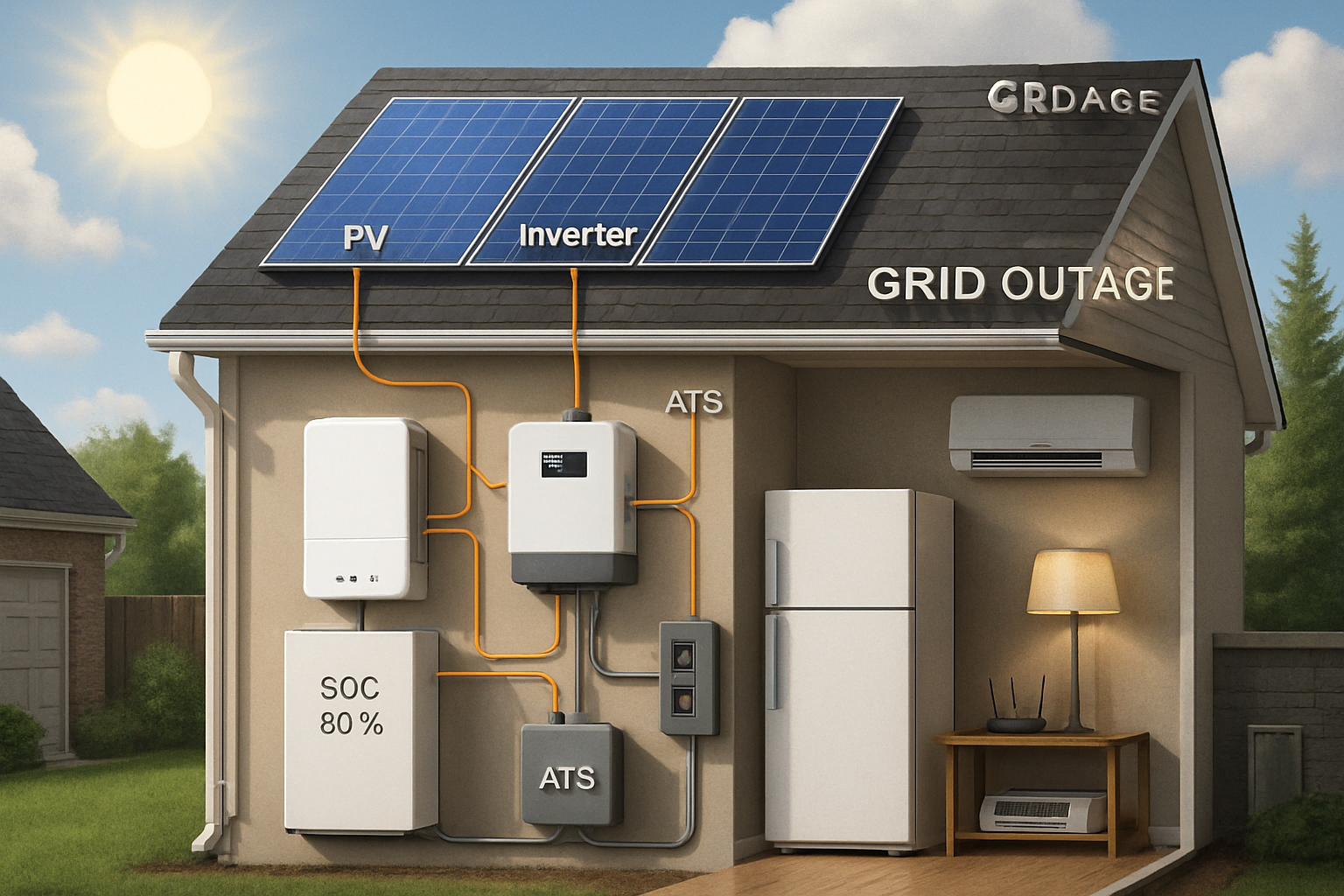Power outages are more than an inconvenience. They stop grid-tied solar panels as a safety requirement. Many homeowners ask if smart inverters can keep solar running during blackouts. The short answer: sometimes, with the right hardware and setup. This Q&A breaks down what smart inverters do, why PV shuts off, and how Battery Storage changes the picture.

Why grid‑tied PV shuts off in blackouts
Anti‑islanding keeps line crews safe
Standard grid‑tied inverters are “grid‑following.” They sync to the utility’s voltage and frequency. During a blackout, they must stop producing power. This is anti‑islanding protection. It prevents back‑feeding the lines that crews may be repairing. It also protects your devices from unstable voltage.
Code rules and trip settings
Interconnection rules require inverters to trip if utility voltage or frequency goes out of bounds. Smart inverters can do more than a basic trip. They provide voltage and frequency support during normal operation. As highlighted by the U.S. Department of Energy, advanced inverters gather PV data and can supply reactive power to help regulate voltage and frequency on distribution feeders. This helps maintain a balanced grid and improves visibility for operators. See EERE Success Story—EPRI Lays Foundation for Smart Inverter Technology.
What smart inverters actually do
Grid support features
“Smart” or “advanced” inverters add functions like volt‑VAR, volt‑Watt, frequency‑Watt, and ride‑through. These features help smooth local voltage and reduce nuisance trips during minor disturbances. They also allow utilities and aggregators to coordinate fleets of PV for grid stability. The U.S. Department of Energy notes that these capabilities are a key enabler for higher solar penetrations on distribution networks. See EERE Success Story—EPRI Lays Foundation for Smart Inverter Technology and the DOE’s topic page Solar Energy.
Backup outputs vs. true backup power
Some grid‑tied inverters offer a limited “daylight backup” outlet. It provides a small amount of AC power (often around 1–2 kW) during sunny hours. This outlet is separate from your main panel and shuts off if clouds pass or PV drops. It cannot start large loads and offers no night power.
True backup during outages needs a “grid‑forming” function. That requires either a hybrid inverter with a battery, or a dedicated battery inverter paired with PV. In this setup, the inverter creates a local microgrid for a critical loads panel and isolates the home from the utility. Smart features remain useful, but the grid‑forming mode is what keeps power on.
Do you need batteries to keep solar running?
Hybrid inverters and Battery Storage
To run appliances during blackouts, pair PV with a hybrid inverter and a battery bank. The hybrid inverter charges the battery during normal operation and switches to islanded mode during an outage. It then regulates voltage and frequency for your critical circuits.
Lithium iron phosphate (LiFePO4) batteries are popular for home storage. They offer stable thermal behavior, long cycle life, and high usable capacity. Global assessments show storage is pivotal for integrating variable renewables and improving reliability at the edge of the grid. See IRENA: Electricity Storage and Renewables—Costs and Markets.
Runtime math made simple
Runtime = usable battery capacity (kWh) ÷ average load (kW). A 10 kWh battery with 90% usable capacity and 92% inverter efficiency nets about 8.3 kWh usable AC.
- Light outage, critical loads ~0.6 kW: about 13–14 hours
- Moderate outage, critical loads ~1.2 kW: about 6–7 hours
- Heavy outage, short bursts (fridge + well pump + lights): depends on duty cycles
PV can recharge the battery during the day, extending runtime. A 6 kW array might harvest 20–30 kWh on a clear day in many regions. Real output varies by season and location. The International Energy Agency tracks PV growth and performance trends; see IEA: Solar PV.
Inverter types and outage behavior
| Inverter type | Grid behavior | Outage capability | Typical use |
|---|---|---|---|
| Standard grid‑tied | Grid‑following; smart functions limited | Shuts off; no backup | Pure net‑metered systems |
| Smart grid‑tied | Grid‑following with volt‑VAR, ride‑through, etc. | May offer small “daylight” backup outlet only | PV with enhanced grid support |
| Hybrid (grid‑forming) with battery | Grid‑following in normal mode; grid‑forming in island mode | Runs critical loads panel; supports PV + battery during outages | Resilient homes and small businesses |
| Off‑Grid Solar inverter | No utility connection; always grid‑forming | Full backup by design; depends on battery and generator | Cabins, farms, remote sites |
Practical Q&A
Can Smart Inverters keep my Solar Panels running in a blackout?
Only if the inverter has a backup output and, for seamless power, a battery. Smart features alone do not create a stable local grid. For whole‑home operation, size the inverter for peak demand and connect a critical loads panel.
Can PV alone power some devices in a blackout?
Some inverters provide a small, isolated outlet during sunny hours. It can run light loads like phone chargers or a laptop. It cannot run large appliances, heat pumps, or deep‑well pumps.
What do I need for full‑featured backup?
A hybrid inverter with grid‑forming capability, a battery bank (often LiFePO4), an automatic transfer switch, and a critical loads subpanel. Add a load audit to prioritize circuits: fridge, lights, outlets for Wi‑Fi and phone charging, gas furnace fan, and medical devices if needed.
Can I charge an EV from solar during an outage?
Technically yes at modest power, if your hybrid inverter supports the EVSE and the battery is large enough. Limit charge rate to protect backup loads. Many owners pause EV charging during blackouts to extend runtime for priority needs.
What about safety and permits?
Use licensed installers. Follow local interconnection rules and electrical codes. Advanced inverter settings should align with utility requirements. The DOE and utility programs encourage smart inverter functions for better grid stability; see Solar Energy.
How to specify a resilient system
Feature checklist
- Inverter: hybrid model with grid‑forming mode, built‑in transfer switch, and PV + battery management
- Compliance: advanced inverter functions aligned with modern interconnection standards
- Battery: LiFePO4 chemistry for safety, cycle life, and usable capacity
- Capacity: size for 8–24 hours of critical loads; consider expansion ports for future growth
- Critical loads: move only priority circuits to the backup panel to avoid overloads
- PV array: ensure daylight charging can cover average daytime use plus some surplus to refill batteries
- Rapid shutdown and labeling: required in many regions for firefighter safety
Quick load reference
- Fridge: 100–200 W average, 800–1200 W start surge
- Gas furnace fan: 300–600 W
- LED lighting (whole home): 50–200 W
- Wi‑Fi + modem + laptop: 30–80 W
- Well pump: 700–1200 W running, higher surge
Select an inverter with surge capability and a battery that can deliver peak amps for motor starts. Hybrid inverters paired with LiFePO4 packs handle surges well and recover quickly.
Real‑world context and data
Solar PV’s share of electricity keeps rising, which places more value on advanced inverter features and Storage. The IEA tracks rapid PV capacity growth and highlights the role of flexible resources to integrate variable generation; see IEA: Solar PV. The U.S. DOE emphasizes that advanced inverters provide data and reactive power support, improving local voltage control and enabling higher PV penetration. See EERE Success Story—EPRI Lays Foundation for Smart Inverter Technology.
On the reliability side, outage duration varies by region and weather. U.S. government data aggregates reliability metrics and outage statistics for electric utilities; see the EIA Electric Power Annual. Storage improves continuity, reduces reliance on portable generators, and can lower feeder stress during restoration. IRENA’s analyses quantify how Battery Storage raises self‑consumption and supports distribution assets during variable PV output; see IRENA: Electricity Storage and Renewables—Costs and Markets.
How our product focus fits
Our team builds resilient energy systems for homes and small sites:
- LiFePO4 lithium battery modules: high performance, safe, and scalable
- Integrated home ESS: hybrid inverter + lithium battery + Solar Panels for seamless backup
- Off‑Grid Solar packages: for remote cabins, farms, and Small businesses
- Grid‑Tied Inverters: high efficiency conversion with advanced grid support
You gain reliable backup, lower bills through self‑consumption, and a clear path to energy independence. System sizes are flexible so you can start small and expand.
Key takeaways
- Smart Inverters add grid support and safety, yet they do not keep power on by themselves during outages.
- For real backup, use a hybrid (grid‑forming) inverter and Battery Storage, ideally LiFePO4.
- Right‑sized batteries plus PV can cover critical loads for many hours and recharge daily.
- Design around a critical loads panel, transfer switch, surge needs, and local code rules.
- DOE, IEA, IRENA, and EIA resources confirm the value of advanced inverters and storage for reliability and grid integration: DOE Solar Energy, IEA Solar PV, IRENA Storage Report, EIA Electric Power Annual.





Leave a comment
All comments are moderated before being published.
This site is protected by hCaptcha and the hCaptcha Privacy Policy and Terms of Service apply.